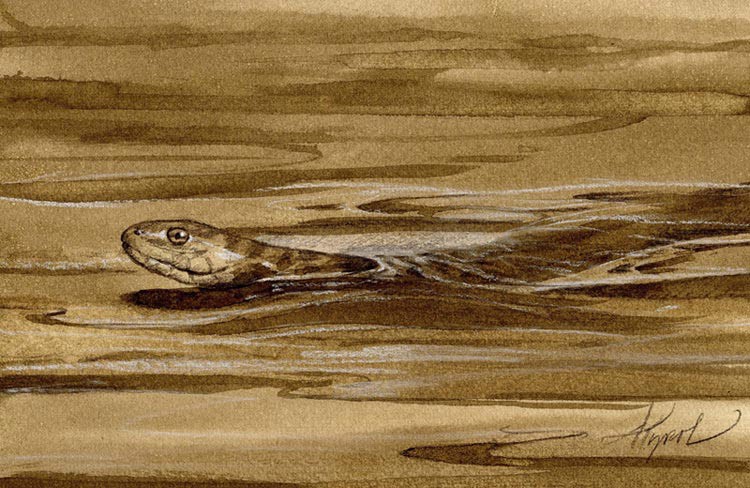
Cottonmouth snakes, also known as water moccasins, do not live in Vermont or New Hampshire. These venomous snakes live only in the South. In spite of this, Michael Marchand, a biologist and reptile expert with the New Hampshire Fish and Game Department, receives many phone calls from concerned citizens who want to report a cottonmouth or water moccasin in their local pond or lake. Only snapping turtles inspire more phone calls.
People are almost certainly seeing the northern water snake, a common, non-venomous snake that spends a lot of time in the water. The northern water snake is harmless, but because of mistaken identity it may be the most feared snake in the region.
“People who are nervous about snakes are even more nervous about snakes in the water,” says Jim Andrews, leader of the Vermont Reptile and Amphibian Atlas Project.
The snake’s relatively large size doesn’t win it friends, either. The species can be up to four feet long, and it’s thicker than most other snakes in our region. “People who aren’t fond of snakes are really not fond of large snakes,” observes Marchand.
Northern water snakes do not have a uniform appearance, which adds to the confusion about their identity. They get darker as they age. Old snakes appear completely black, with dark, crescent-shaped spots on their bellies. Younger snakes have dark crossbands on their necks and reddish-brown blotches on their light-colored bodies.
Given the frequent phone calls, one might think that Andrews and Marchand would know everything there is to know about the snake, but there are some gaps in the species’ range map. Biologists depend primarily on reports from the public to know where reptiles and amphibians are in their respective states. In Vermont, records for northern water snakes from the Champlain Valley abound, particularly from places where many people kayak and fish, such as Shelburne Pond, Button Bay, and East Creek. But they don’t have as much data from less popular waterways.
Andrews notes that while many distribution maps show the entire state of Vermont as being within the range of the northern water snake, a more detailed view would show that it is a valley snake. It’s not in the mountains, and so is missing from the center of the state.
“From my experience they seem to like places where warm, shallow water with lots of good fish habitat and rocks come together,” says Andrews. The snakes like to be able to climb out of the water and right into the crevice of a rock. “Sometimes they use man-made structures, like a stone bridge or a fishing access with rock fill, because they provide just that.”
In New Hampshire, as well, reports of the species reflect more where observers are than where the snakes may be. It is well-documented in New Hampshire’s densely-populated southeastern corner. It is not found in the White Mountains, but otherwise it appears to be so common throughout the state that Marchand sometimes forgets to note every time he sees one.
It surprises Andrews, though, that there have been no confirmed reports of the northern water snake along the Connecticut River. The snake can find everything it likes there: water, fish, and rocks. And Massachusetts records seem to indicate water snakes in the Connecticut’s southern waters. However, records stop north of Vernon, Vermont. There have been a couple of recent reports from Rockingham, Vermont, but without photos they can’t be confirmed.
Are there northern water snakes along the Connecticut River in our region? That’s a question that Marchand and Andrews can only answer with your help. The best time to look for the snakes, Andrews says, is April, when cold water and warm air entice them to bask in the sun outside their winter dens with little vegetation to hide them from view. The second best time to look is right now – in September and October. The snakes slither overland to their denning locations, which are deep in rock crevasses, and bask in full view on warm days.
In New Hampshire, the Reptile and Amphibian Reporting Program (RAARP) website links to three ways to report snakes. In Vermont, you can file a report of a water snake sighting here. Photos are helpful.


Discussion *